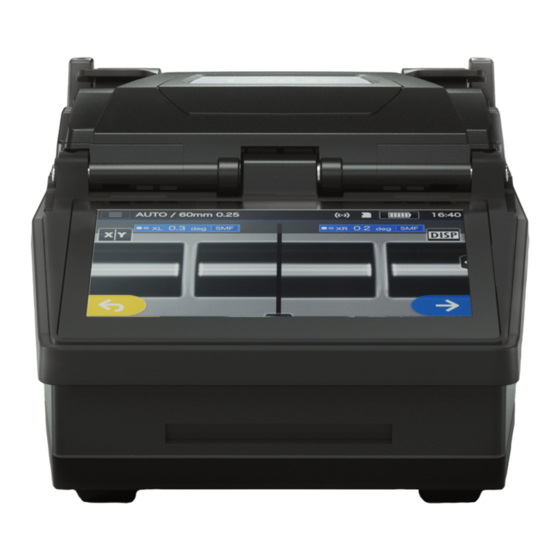
Advertisement
TYPE-Q502S
Quick Reference Guide
■Home screen
Splice Program
Heater Program Wireless LAN SD
Display the Settings panel
Power source type
Change image view
Display/Non-display icons
Start the splicing process (Set icon)
Start the arc test (Arc test icon)
■Settings panel
To display the Settings panel, tap the
Settings panel icon (
Power
Home screen icons
) on Home screen.
Settings panel icons
Display the menu screen.
Set up Splice Program.
Set up Heater Program.
Play Help Videos.
Log
in
to
Administrator
mode by entering passcode.
Turn on/off the sound.
Time
Heater panel
Control panel
Long press: Power ON/OFF
Quick press: Reset
Start the heating process (Heater icon)
View splice data after splicing
Adjust the zoom of a fiber image
Adjust display brightness
Capture a fiber image
■New Technology
NanoTune™
The splice error prevention system
While splice program is selected to "AUTO
NanoTune",
the
cleaved fiber surface and then sets up optimal
splice condition.
When the NanoTune™ is applied to poor fiber end face, a
NanoTune™ screen appears. Even in AUTO NanoTune program, the
Nanotune™ is not applied to good end face, and the usual splice
screen is displayed.
Using keypad
NanoTune
analyzes
™
the
Advertisement
Table of Contents

Summary of Contents for Sumitomo TYPE-Q502S
- Page 1 TYPE-Q502S Quick Reference Guide ■Home screen Splice Program Heater Program Wireless LAN SD Power Time Using keypad Heater panel Control panel Long press: Power ON/OFF Quick press: Reset Home screen icons Display the Settings panel Start the heating process (Heater icon)
- Page 2 * ”Quick” heater program only shrink oven. Sumitomo Electric Industries, Ltd. reserves the right to change the specification or design without OME2024102-2/Ver.1.00 notice and may therefore not coincide with the contents of this quick reference guide. E&OE For further detailed operating instructions and functions, please see Operation manual.
Need help?
Do you have a question about the TYPE-Q502S and is the answer not in the manual?
Questions and answers